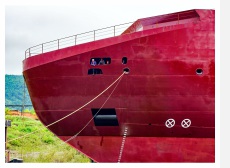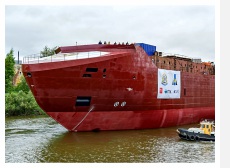 01.08.19 17:14 01.08.19 17:14
Amur Shipyard launched the lead CNF11CPD cargo-passenger car-railway ferryboat "Alexander Deev" for Valino-Kholmsk line
  
According to the press service of the governor and the government of the Khabarovsk Region, the Amur Shipyard (General Director Vladimir Kulakov) launched the hull of the lead CNF11CPD cargo-passenger car-railway ferryboat "Alexander Deev" (building No. 300). She is new generation vessel of ice-breaker type of unlimited navigation area for Vanino-Kholmsk line.
Project documentation for the under construction vessel was developed by the Marine Engineering Bureau, working-design and technological documentation- by Vympel Design Bureau.
It is reported that "... a special ship-lifting pontoon was prepared for the forwarding of" Alexander Deyev" to the Amur River water area and her subsequent completion at the Amur Shipyard. This pontoon allowed to facilitate the floating of the hull. Recall that the vessel has height as a five-storey building; she was built at different workshops. The last three blocks left the welding shop in April. And in May, a unique operation took place on welding parts of the new ferryboat. The work on an open slipway is not quite a familiar construction technology for shipbuilders; however the brigades successfully coped with the task.
"In parallel, works on preparing the outer hull of the ferryboat for painting and ballast tanks testing are continued. Mounting and installation of outside fittings and sea-valve boxes are carried out. However, the main forces of shipbuilders are concentrated on preparing the vessel for the mounting of the shaft lines,"said Yuri Lysenkov, the main builder of PJSC Amur Shipbuilding.
The operating mode at the vessel is almost round-the-clock. Over 300 people work at the vessel. According to the approved schedule, the ferry will leave for Vladivostok for the final works, tests and further putting into operation in August 2020".
Source of photo materials is the news portal "Komcity.ru".
CNF11CPD project of the car-railway-cargo-passenger new generation ferryboat for the Vanino-Kholmsk line provides in comparison with the existing "Sakhalin" type vessels:
• enhanced cargo capacity (truck cars capacity is 2 times bigger);
• weather restrictions absence (unrestricted sailing region);
• ability of working in severe ice conditions (speed is 6-8 kn at 80 cm ice and about 3 kn at 1.0 m ice);
• ability to carry out independent (several times per day) moorings without towing assistance;
• ability for long reverse movement through constrained water area of the port of Kholmsk;
• ability to keep up daily cycle of round voyage (operation speed is 18 kn);
• 2-hours staying for loading-unloading operations.
The CNF11CPD vessels are intended for transportation of Russian standard railway.
trains with gauge of 1520 mm, all types of cars, including car trains with 12 (13.5) m semi-trailer trucks and container platforms, various wheeled vehicles and containers on roll trailers, up to 30 ref. containers, as well as dangerous goods of classes 1.1-1.6; 1.4S; 2.1-2.3; 3; 4.1-4.3; 5.1; 6.1; 8 and 9 in accordance with the provisions of the International Maritime Dangerous Goods (IMDG) Code and the National Maritime Dangerous Goods Regulations (MOPOG Rules).
Transportation is foreseen of at least of 32 railway wagons or 27 car trains on the main deck, 12 car trains on the lower deck and about 9 cars (1.5 tons).
The new CNF11CPD ferry boats will allow the Sakhalin producers to forward products to the mainland in time; will provide food security and expand possibility of transportation for certain types of cargo.
The number of passengers (200 people) accepted in the new project reflects the peak line need at a summer season vacations and is set according to the offer of the Sakhalin Region Government; it is essentially important to provide solving of a social problem of recreation providing for the region's population 200 passengers distribution is as follows: 16 ones at double cabins with water closets, 96 ones at four-berth cabins with water closets and 88 ones at saloon chairs.
The new concept is the result of a series of studies conducted in 2012-2013 by the Marine Engineering Bureau in collaboration with leading domestic and foreign scientific institutes, including Aker Arctic Technology (recommendations for contours, tests in the ice pool), Central Research Institute of the Marine Fleet (examination of technical solutions for all stages, formation of contours, economic calculations and modeling of operation), Krylov State Scientific Center (towing tests, self-propelled, nautical, as well as testing in ice basin), design bureau of the carriage facilities of JSC Russian Railways (checking the possibility of transporting rolling stock by ferry).
CNF11CPD characteristics in ice conditions according to the results of tests in the pool are: the maximum ice permeability at V = 3 knots forward will be 1.16 meters, at a speed of V = 6 knots it will be 0.84 meters, in reverse with a speed of V = 1.5 knots will be 0.68 m.
In addition, the bow and stern extremities are structurally designed for a higher ice category (Arc 7).
Together with the icebreaking at the level of the Icebreaker6 icebreaker, this allows (unlike the existing vessels) independent operation of the new ferry in severe ice conditions on a short passage (up to about 30 miles in the vicinity of Vanino). In turn, this will allow to avoid ferry's significant downtime in anticipation of general icebreaking assistance, or excessive costs in case of individual assistance.
At one time, the ferry was built to serve the railway transportation, but recently, the increasing part of the ferry routes began to take the vehicles transport. A new type of cargo (heavy trailers (trucks) and cars) has appeared. In connection with the construction of the Lidoga-Vanino highway, the share of road transport will increase. In addition to transporting cars and trailers, shippers have another potentially new type of cargo for the ferry line: containers and roll trailers with heavy equipment. Therefore, while maintaining the function of transporting railroad cars (the length of rail tracks is 440 linear meters at 420 on the existing one), the capacity for cars has doubled (740 linear meters against 394 on the existing one). As a result, 39 new trucks with semi-trailers (12-13.5 m length ) and an additional 9 cars can be accommodated on the new ship.
In addition to the stern cargo handling scheme, which is definitely tied to the ports of Vanino and Kholmsk terminals, an on-board ramp is installed for working with rolling equipment directly to the pier, which allows the use of a new vessel (for example, for commercial flights to Japan).
The keel of the lead CNF11CPD vessel (building No. 00300) "Alexander Deev" was laid down on 29.0617. She was launched on 01.08.19.
The keel of the second vessel (building No. 00301) "Vasily Oshchepkov" was laid down on 29.06.2017.
|



